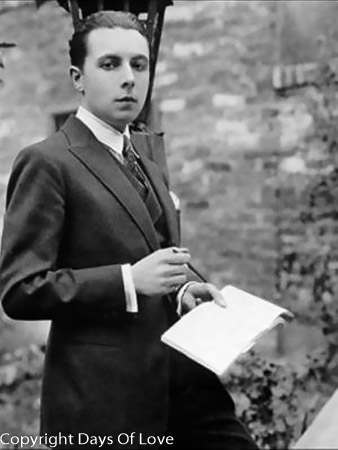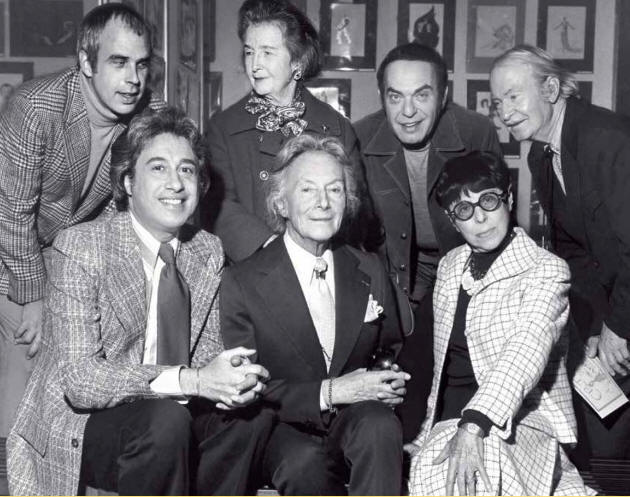

Partner Nicolas Ouroussoff
Queer Places:
Académie Julian, Passage des Panoramas, Paris, Francia
21 Rue Gutenberg, 92100 Boulogne-Billancourt, France
Cimetière de Boulogne-Billancourt, Boulogne-Billancourt, Francia
 Romain
de Tirtoff (23 November 1892 – 21 April 1990) was a Russian-born French artist
and designer known by the pseudonym Erté, from the French pronunciation of his
initials. He was a diversely talented 20th-century artist and designer who
flourished in an array of fields, including fashion, jewellery, graphic arts,
costume and set design for film, theatre, and opera, and interior decor.
Romain
de Tirtoff (23 November 1892 – 21 April 1990) was a Russian-born French artist
and designer known by the pseudonym Erté, from the French pronunciation of his
initials. He was a diversely talented 20th-century artist and designer who
flourished in an array of fields, including fashion, jewellery, graphic arts,
costume and set design for film, theatre, and opera, and interior decor.
Tirtoff was born Roman Petrovich Tyrtov (Роман Петрович Тыртов) in Saint Petersburg, to a distinguished family with roots tracing back to 1548, to a Tatar khan named Tyrtov.[1] His father, Pyotr Ivanovich Tyrtov, served as an admiral in the Russian Fleet.
In 1907, he lived one year in Paris. He said about this time "I did not discover Beardsley until when I had already been in Paris for a year".
Demoiselle à la balancelle is one of Erté's first sculptures, if not the first. Made in 1907, at the age of 15 years, during a stay in Paris. This work is less precise than his other sculptures, but still Art Nouveau. Erté considered this so minor and uninteresting that it does not appear in his official biography, but the cartouche on the back indicates 'ERTE PARIS 1907', in a triangle.
In 1910–12, Romain moved to Paris to pursue a career as a designer. In Paris he lived with Prince Nicolas Ouroussoff (December 17, 1879 – April 8, 1933) up until the prince's death in 1933.[2] The decision to move to Paris was made despite strong objections from his father, who wanted Romain to continue the family tradition and become a naval officer. Romain assumed his pseudonym to avoid disgracing the family. He worked for Paul Poiret from 1913-1914. In 1915, he secured his first substantial contract with Harper's Bazaar magazine, and thus launched an illustrious career that included designing costumes and stage sets. Between 1915–1937, Erté designed over 200 covers for Harper's Bazaar, and his illustrations would also appear in such publications as Illustrated London News, Cosmopolitan, Ladies' Home Journal, and Vogue.[3]

Back Row (L to R), Bill Hargate, Sheila O'Brien, Michael Woulfe, and
Howard Shoup, Front Row (L to R) Burton Muller, Erte, Edit Head.
Erté is perhaps most famous for his elegant fashion designs which capture the art deco period in which he worked. One of his earliest successes was designing apparel for the French dancer Gaby Deslys who died in 1920. His delicate figures and sophisticated, glamorous designs are instantly recognisable, and his ideas and art still influence fashion into the 21st century. In 1920 he designed the set and costumes for the film The Restless Sex starring Marion Davies and financed by William Randolph Hearst. His costumes, programme designs, and sets were featured in the Ziegfeld Follies of 1923, many productions of the Folies Bergère, Bal Tabarin, Théâtre Fémina, Le Lido[4] and George White's Scandals.[5] On Broadway, the celebrated French chanteuse Irène Bordoni wore Erté's designs.
In 1925, Louis B. Mayer brought him to Hollywood to design sets and costumes for the silent film Paris. There were many script problems, so Erté was given other assignments to keep him busy. Hence, he designed for such films as Ben-Hur, The Mystic, Time, The Comedian, and Dance Madness. The celebrated Russian designer arrived with his lover, Nicolas Ouroussoff, whose expenses were also picked up by the studio. Mayer, whose antipathy to homosexuals was well known, nonetheless invited Erté and Ourossoff to dinner with his family. "On the basis of my own releationship with him," Erté would recall, "I could never understand how the legend of his quick temper and difficult character had developed. In all my dealings with him I never saw any sign of either.
By far, his best known image is Symphony in Black, depicting a somewhat stylized, tall, slender woman draped in black holding a thin black dog on a leash. The influential image has been reproduced and copied countless times.[6]
Erté continued working throughout his life, designing revues, ballets, and operas. He had a major rejuvenation and much lauded interest in his career during the 1960s with the Art Deco revival. He branched out into the realm of limited edition prints, bronzes, and wearable art.[7]
Two years before his death, Erté created seven limited edition bottle designs for Courvoisier to show the different stages of the cognac-making process, from distillation to maturation.[8] In 2008, the eighth and final of the remaining Erte-designed Courvoisier bottles, containing Grande Champagne cognac dating back to 1892, was released and sold for $10,000 a piece.
His work may be found in the collections of several well-known museums, including the Victoria and Albert Museum, the Metropolitan Museum of Art, and the Los Angeles County Museum of Art (LACMA); as well, a sizable collection of work by Erté can be found at Museum 1999 in Tokyo.
My published books: